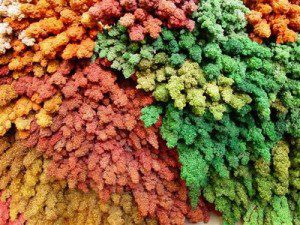Contributing Writer for Wake Up World
My eldest daughter was making dinner last week and mistakenly rinsed twice as much quinoa than what the recipe called for. She divided the amount into two batches and stuck one closed container of it into the fridge. Over the course of a few days and numerous small hands pushing the container around, it ended up in back of the rest of the food choices and forgotten. When I discovered the bowl and opened the lid I found some beautiful sprouted red seeds. When I asked which one of my monkeys started this science experiment of course all fingers pointed to Rhiannon who sheepishly apologized for not telling me. I grinned and said it was better than finding the mold covered “gloop” in the pantry the week before and in fact we were going to EAT this mistake. So I had the little ones run out and clip lettuce leaves, green onions and snow peas and I chopped a pineapple that a friend gave us with some red bell pepper and left over chickpeas. I had brown rice miso paste that was mixed into the quinoa seeds, tossed all the other ingredients into it and voila! a fresh living salad!
Quinoa is a very cool food. It is treated like a grain but is actually a seed and closely related to beets and spinach.
Because it is a seed quinoa has no hulls to remove. It is however covered with a bitter substance called saponin, which is a protection by the plant that birds won’t touch. Because of this coating, quinoa requires thorough rinsing before cooking. One method is to put the grain in a blender with cool water at lowest speed, changing the water until it is no longer soapy. Commercial quinoa has had most of the saponin removed though it is still a good idea to give it a quick rinse before preparing. In South America the saponin is also used for detergent and as a topical antiseptic on skin injuries.
I’m told that young quinoa greens are delicious mixed into salad and are high in several nutrients such as calcium and iron. The leaves are also high in oxalic acid though and should be eaten in moderation.
Older greens can be used steamed, or lightly sauteed. I would love to try them but may have to grow some of my own as I believe the only commercial quinoa growers in Australia reside in Tasmania. And of course, sprouted anything is more nutritious than not. Our previously mentioned “mistake” was enhanced tremendously by a minimum amount of effort and when sprouted is full of life giving enzymes and boosted levels of vitamins and minerals when eaten without cooking.
Quinoa is also a brilliant addition to casseroles and stews and they make fabulous vegetarian burger patties. I had some left over black bean stew the other day and added some quinoa and sweet potato and we enjoyed the burgers for lunch.
It makes a super breakfast cereal as well;
Breakfast Quinoa with Coconut Milk
A very quick and nutritious breakfast!
1/2 cup dry quinoa, rinsed
3/4 cup organic coconut milk
1 tsp organic vanilla extract
1/2 tsp organic cinnamon
pinch of good quality sea salt
1/3 cup toasted or raw organic nuts such as almonds or macadamia
Fresh fruit of choice such as bananas, shredded apple or mango
Sweetener of choice, we prefer organic coconut sugar or dark agave
Mix quinoa, coconut milk, cinnamon and vanilla in a small saucepan and bring to a boil. Reduce to a simmer, cover and let cook for up to 15 minutes or until quinoa is light and fluffy.
Divide quinoa into two bowls and serve with your favorite fruit and nuts.
Peru and Bolivia are still the leading producers of quinoa but it is being successfully grown in many other areas. Canadian growers have been flourishing recently and providing North America with this popular health food.
Quinoa is thought to be originally domesticated in the Peruvian Andes and was considered one of three sacred foods. Potato and corn were the other two. Quinoa is a nutrient dense food which has gained popularity due to its high amounts of easily digestible protein. And the fact that it is gluten free. I don’t particularly care about the gluten free angle in my family as we don’t eat highly processed foods. Ingesting small amounts of gluten found in moderately processed foods like spelt and oats is different from gluten found in todays manufactured food. Most of the problems with gluten are derived from a diet that has large amounts of refined carbohydrates in it coupled with a lack of fresh organic living and fermented foods. Packaged foods are convenient but unfortunately we are eating the same few foods over and over. These foods are just flavored differently so it is easy to overlook that fact. Living out of balance with nature will always create health problems.
Quinoa was traditionally grown with sustainable methods allowing llamas to roam freely through the fields to keep weeds down and fertilize. As the demand for quinoa grew though so did the need to move the llamas out of the fields and lack of nutrition became evident. Many small farmers recognized the problem and brought the old ways back but sadly not all of them have. Cultivars in Colorado and other areas are using the typical non-sustainable practices of fertilizing and herbicide use. According to Purdue University , Preemergence herbicide trials have been conducted in field and greenhouse locations in Colorado. Several herbicides were used safely on quinoa, but were variable in weed control. Enough said, it is organic for me.
According to Salt Spring Seeds, an ounce or two of seed per plant is common but you can easily get over six ounces per plant when grown in compost. Normal commercial yields for quinoa are 1200 to 2000 pounds (500-900 kg) per acre. Full harvest potential is yet to be realized and much higher results are obtained from labour-intensive harvesting: yields of over 5,000 pounds per acre have been reported from Central and South America.
As always though, with commercial endeavors there is a dark side. In a 2011 NY Times article there is concern that native peoples that are growing and exporting quinoa are no longer able to afford this food as prices increase. Unfortunately it is probably more the fact that as commercial success for poorer areas increase so does accessibility to modern processed and packaged foods.
About the Author
Jeani-Rose Atchison is a health advocate, and home-schooling mother of five who also finds time to write about nutrition, whole foods and environmental concerns. She authored, Every Day Vegan – 300 recipes for healthful eating which is a mainstay in vegetarian kitchens. Atchison’s latest book, Food for Thought – Thought for Food is chock full of delicious whole food recipes. It also takes a controversial look at the food we eat today and the processes involved in bringing it to your table. Can your food make you ill? The answer may shock you!
To find out more go to Jeani-Rose’s Facebook or Website

If you've ever found value in our articles, we'd greatly appreciate your support by purchasing Mindful Meditation Techniques for Kids - A Practical Guide for Adults to Empower Kids with the Gift of Inner Peace and Resilience for Life.
In the spirit of mindfulness, we encourage you to choose the paperback version. Delve into its pages away from screen glare and notifications, allowing yourself to fully immerse in the transformative practices within. The physical book enriches the learning process and serves as a tangible commitment to mindfulness, easily shared among family and friends.
Over the past few years, Wake Up World has faced significant online censorship, impacting our financial ability to stay online. Instead of soliciting donations, we're exploring win-win solutions with our readers to remain financially viable. Moving into book publishing, we hope to secure ongoing funds to continue our mission. With over 8,500 articles published in the past 13 years, we are committed to keeping our content free and accessible to everyone, without resorting to a paywall.







